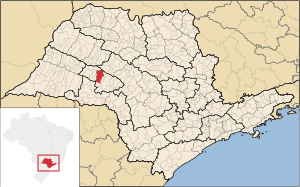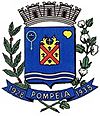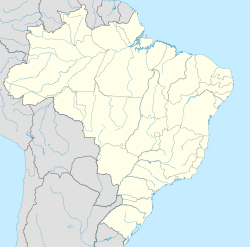Pompeia, São Paulo facts for kids
Quick facts for kids
Pompeia
|
|||
|---|---|---|---|
|
Municipality
|
|||
|
|||

Location in São Paulo state
|
|||
| Country | Brazil | ||
| Region | Southeast | ||
| State | São Paulo | ||
| Area | |||
| • Total | 784 km2 (303 sq mi) | ||
| Elevation | 597 m (1,959 ft) | ||
| Population
(2020)
|
|||
| • Total | 22,172 | ||
| • Density | 28.281/km2 (73.25/sq mi) | ||
| Time zone | UTC-03:00 (BRT) | ||
| • Summer (DST) | UTC-02:00 (BRST) | ||
Pompeia is a city located in the state of São Paulo in Brazil. As of 2020, about 22,172 people live there. The city covers an area of 784 square kilometers. In 2000, Pompeia had a high Human Development Index, which means it was a good place to live.
Contents
History of Pompeia
Early Inhabitants and First Settlers
The area where Pompeia is now was first home to the Kaingang people. The Portuguese colonizers called them Coroados, meaning "Crowned."
In 1852, the first settlers arrived. The Imperial Government gave land to João Antonio de Moraes, Francisco de Paula Morais, and Francisco Rodrigues de Campos. This land was near the Rio do Peixe and Aguapeí River (São Paulo) rivers. These early settlers were like explorers, called Bandeirantes, who helped open up new areas.
Founding the City
In 1919, a man named Júlio da Costa Barros bought part of a large farm called Guataporanga. He wanted to use the land for farming. Over the next three years, the first coffee plantations started to grow there.
Later, Barros founded a small village called Vila de Novo Cravinhos. He named it after Cravinhos, where his first customers came from. Around the same time, people started clearing the land. They were also building the Noroeste do Brasil Railroad. This railroad was meant to connect the cities of Bauru in São Paulo and Corumbá in Mato Grosso do Sul.
How Pompeia Got Its Name
Jacutinga Farm was the first big farm in the area. Its owner, Rodolfo Lara Campos, bought it to grow a lot of coffee as a profit crop. He began clearing the forests where Pompeia would later be built.
In 1928, Rodolfo and Luiz Miranda planned to create a city. They cleared a 250 hectare area, which is about 618 acres. They called this new area Patrimônio de Otomânia. They divided it into smaller pieces of land and started selling them. A few years later, Patrimônio was officially renamed Pompeia. This new name honored Senator Rodolfo Miranda's wife, Aretuza Pompeia.
Immigrant Influence
Like many cities in São Paulo, Pompeia was settled by many immigrants. People came from Portugal, Italy, and Japan. The Japanese culture is still very noticeable in Pompeia today. You can see it in traditional festivals and in the design of some buildings. For example, many bus stops have roofs with curved eaves, which is a Japanese style.
Education in Pompeia
Pompeia is known for its excellent education system in São Paulo. It is even recognized across Brazil. The city was listed as one of the 500 best cities for education in the country.
Since 2013, the Shunji Nishimura Foundation of Technology has helped a lot. It works with a technology college, Faculdade de Tecnologia. This college offers courses in Mechanized Precision Agriculture and Big Data in Agribusiness. These courses teach students how to use technology in farming. This has helped Pompeia become an important center for higher education.
Máquinas Agrícolas Jacto
The Jacto Group's Beginning
The Jacto Group is a very important company in Pompeia. It was started in 1948 by a Japanese immigrant named Shunji Nishimura. He came to Brazil in 1932. Shunji Nishimura studied at the Kyoto City First Technical School in Japan.
With his family, Nishimura developed special equipment for farming. Farmers and agricultural families in the countryside of São Paulo and other states of Brazil really liked this equipment. It became very popular.
Impact on the City
Jacto Group is one of the top businesses in Pompeia. It brings a lot of money to the city and the Midwestern part of São Paulo state. The Nishimura family also created the Shunji Nishimura Foundation of Technology.
This foundation helps farmers by testing their soil to see how fertile it is. They also analyze plant tissues. The foundation works to keep improving technology in farming areas.
See also
 In Spanish: Pompeia para niños
In Spanish: Pompeia para niños




